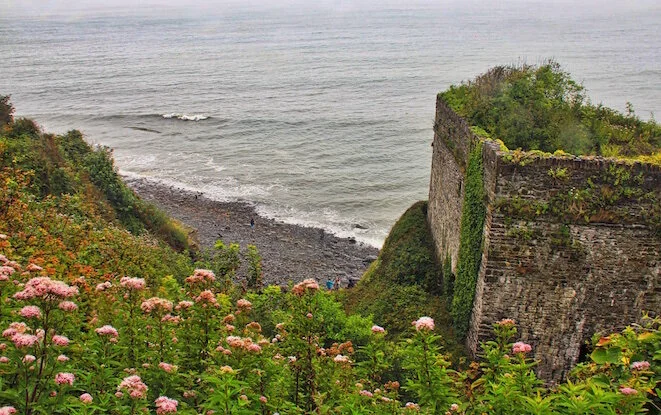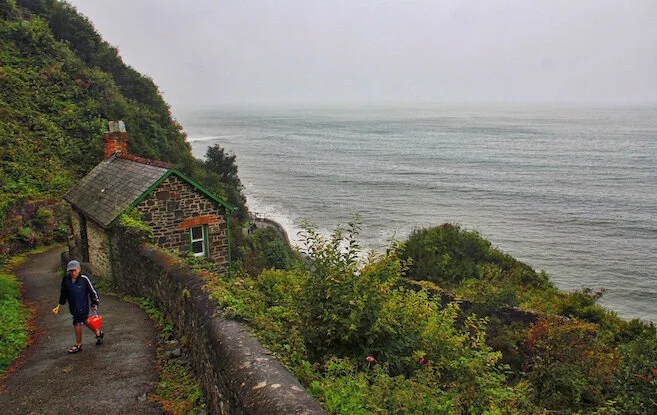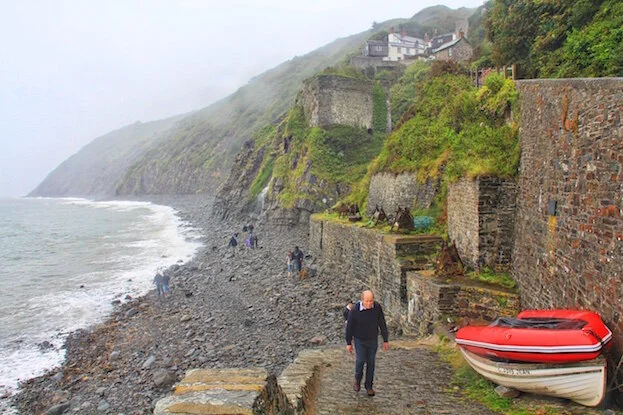Devon Walks - Bucks Mills
Another walk for a rainy day in the West Country…
Lonely, remote, dramatic, sweeping stretches of coastline… Such places are one of the hallmarks of our peninsula. Wherever you find a well-trodden bay full of tourists and sandcastles, you can be sure that a wild and little-visited shore will be lying not much more than a gull's shriek away.
Especially when it is raining. Which is what it was doing in stair-rods the other day when I found myself on the untrodden expanse of shore that stretches west from Westward Ho!
It's ideal walking territory, but Clovelly is the only bit most people ever get to see. From the village's fine old stone quay you get a great view of the perpendicular, wooded, coast that heaves the county's northern-western shoulder at the sea.
To east of Clovelly there are places like Buck’s Mills and Peppercombe - which are the twin venues for this walk.
To find the former you must go to Buck’s Cross on the A39 between Bideford and Clovelly. A lane drops seawards from here down through beautiful steep woodlands and just before it reaches the hamlet of Buck’s Mills there’s a car park.
Climb out of your car and all trace of the 21st century, is gone. You find yourself in a sylvan world of magical beauty in which a brook skips and scurries down a dark ravine in its brief journey to the sea. As it plunges it passes cottages that punctuate the valley as if they were placed by some clever pastoral landscape designer.
It is all most alluring - but I’d made up my mind to do a circular walk and so turned right where two wooded combes meet at the heart of the hamlet. By walking up through paths in the woods I was able to reach Lower Worthy Gate- then, by turning left, we climbed further to Higher Worthy Gate and so reached the tiny quiet lane that runs east over to Peppercombe.
Eventually we came to the small spur which departs this lane to the right at the hamlet of
, and a few yards down came to a public footpath on the right. This took us down through woods to the depths of Peppercombe-proper where we turned left again down the track that leads to the sea.
The area was bought by the National Trust in 1988, and was all part of the large Portledge Estate. The strangely named Pine-Coffin family ruled the roost here ever since they acquired the land during Henry II's reign, back in the mid-12th century.
Peppercombe, according to a Trust leaflet, not only boasts rare lichens but: “There are woodland plants such as moschatel, sweet woodruff and wood millet. Within the areas of open grassland, marsh orchid, early purple orchid, ragged robin and betony are found, as well as the pearl bordered fritillary and dingy skipper butterflies.”
Exotic stands of bamboo and fig lurk in the coombe adding a visual whiff of something as oriental as opium - their verdant luxuriance, somehow just as acceptable in this Atlantic glade as they would be in some far-flung oasis or paddy-field. The gardeners of the great estate put them here and the exotics have flourished. Call me a romantic fool, but I like the way in which a big, elegant, ever-rustling display of bamboo manages to warm the cold cockles of my northern heart.
Towards the bottom of the coombe our track joins the South West Coast Path and, shortly after, follows it almost vertically up the wooded hill to the left. But, before you ascend, take my advice and go down to the beach.
It's a stiff climb indeed that takes you west up from the bungalow to Sloo Wood, but once you're up there it's fairly level going along to Gauter Pool above Worthygate Wood.
We continued along the coast to eventually make the long descent down to Buck's Mills. There used to be a small quay here after a break in the rocks, known as the Gut, was created by blasting the rock with gunpowder in the Elizabethan era. this created a small harbour for fishing boats and later, in the 18th century, the place was used for the import of culm which was burnt in the kilns you can still see to produce fertiliser.
The massive kilns that still dominate this steep coastal demesne, almost like ruined castles, were used to burn this mix of anthracite and limestone. But it must have been damned hard work hauling both the raw materials up from the beach, then taking the resultant mix on up the combe.
The Braund family used to rule the roost in this valley and I am told that King Cottage was once the home of Captain James Braund who was known as the King of Bucks.
Neither he nor his ghost - or anyone else for that matter - was around the day we called by. But I did learn about the Braund Society which was founded in 1982 by the late Cyril John Braund to “promote the study of the history, biography and genealogy of the Braund family and to encourage friendship and fellowship between its members”.
I read that some claim the Braunds - noted for their dark hair, broad heads and brown eyes - owed their existence to local women who married survivors of a Spanish Armada ship, wrecked on the North Devon coast more than 400 years ago. However, I am told this myth is debated by the Braund Society which claims that documentary evidence shows the clan lived in Devon long before the 16th century.
For some reason I rather like the idea of swarthy folk haunting this lonesome shore and using its natural ingredients, perhaps, to make a North Devon form of paella and other Spanish seafood.
But the Spanish sun seemed a long way away the day we were there - heavy May-time rain had settled in for the day and we made our way up through the hamlet as fast as we could - happy at least to have enjoyed a pleasant taster of North Devon's secret coast.










